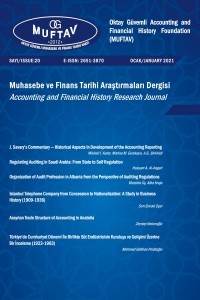XX. Yüzyılın İlk Yarısında Türk Muhasebe Düşüncesinin Gelişimini Etkileyen Eğitimciler: Serkiz Nihad
XIX. Yüzyılın ikinci yarısında çift yanlı kayıt yöntemi ile tanışan Osmanlı, Fransız kültüründen yararlanarak ve eğitim sürecini hızlandırarak bir alt yapı oluşturmuş ve 1879 yılında Padişah Fermanı ile devlet çift yanlı kayıt yöntemine fiilen geçmiştir. XX. Yüzyıln başlarında sürekli savaşlar nedeni ile muhasebe düşüncesinde fazla bir gelişme sağlanamamış ve bu gelişmeler, Ticaret Mekteb-i Alisi’nde kümelenen hocaların mesleği geliştirme çabaları ile sınırlı kalmıştır. Bu hocalar arasında Serkiz Nihad, Kirkor Kömürcüyan gibi Ermeni asıllı eğitimciler de vardır.Cumhuriyet ile birlikte muhasebe kayıtlarından ve mali tablolardaki veriler üzerinden vergi alınmaya başlanması muhasebe düşüncesinin hızlı bir gelişim sürecine girmesini temin etmiştir. Bu süreç içinde muhasebe düşüncesinin gelişme düzeyini Serkiz Nihad’ın eserlerinden izlemek olanağı vardır. Serkiz Nihad’ın bir uzlanım muhasebesi öğretim kitabı olan Sigorta Muhasebesi adını taşıyan ve 1926 yılında yayınlanan kitabı incelendiğinde, hem defterlerin ve hem de mali tabloların, sağdan sola yazıyı esas alan Osmanlıca’nın kullanımı nedeni ile borç tarafına (aktif) sağda, alacak tarafına (pasif) solda yer verildiği görülmektedir. Bu ters uygulamaya rağmen, bilançonun varlık ve kaynak taraflarının kavramsal olarak uygun yapıda olduğu, ancak varlık ve kaynak unsurlarının sıralanmasında bir düzen bulunmadığı dikkati çekmektedir. Kar ve zarar tablosunun ise, gelir tablosu anlayışına uygun bir nitelik taşıdığı ve özellikle sigorta türleri itibarı ile gelir ve giderlere ayrı ayrı yer verildiği gözlenmektedir.Cumhuriyet’in ilk yıllarında çift yanlı kayıt yöntemindeki bu gelişmelerin 1928 yılında Latin alfabesine geçilmesi ile hızlandığını belirtmek gerekmektedir. Soldan sağa yazı tekniğine göre gelişen çift yanlı kayıt yönteminin önü, Latin harflerinin kabul edilmesinden sonra açılmıştır.
Anahtar Kelimeler:
Türk muhasebe düşüncesi, XX. yüzyıl başları, Serkiz Nihad.
Educators Effecting the Development of Turkish Accounting Thought in the first half of the XX. Century: Serkiz Nihad) (Deceased 1952)
The Ottoman State got acquainted with the double entry accounting system in the second half of the XIX. Century. They quickened the education process and established an infrastructure while benefiting from the French culture. The Ottoman State effectively began using the double entry accounting system in 1879. Because of the wars, they lack progress in the accounting thought in the beginning of the XX. Century. Progress in the accounting thought was limited with the efforts of the educators clustered around the Ticaret Mekteb-i Ali. Serkiz Nihad and Kirkor Kömürcüyan were one of the Armenian originated educators. With the establishment of the Republic, the development of accounting thought quickened when tax were imposed out of accounting records and financial statements. It is essential to watch the level of development in the accounting thought from the works of Serkiz Nihad. Serkiz Nihad had a book called Assurance Accounting dated 1926. In his book, he put the assets (active) in the right, liabilities (passive) in the left due to the specialties of the Ottoman language, which was written from right to left. Despite this opposite implementation, it is observed that there is no order in the arrangement of assets and liabilities. Profit and loss statement has a suitable attribution regarding todays’ income statement. It is observed that revenues and expenditures are shown separately in respect to the sorts of assurances. These developments in the double entry accounting system within the first years of the Republic were quickened with the first usage of the Latin alphabet in 1928. The development of the double entry accounting system gained wide usage with the acceptance of the Latin characters.
- ISSN: 2146-4928
- Yayın Aralığı: Yılda 2 Sayı
- Başlangıç: 2011
- Yayıncı: Oktay Güvemli Muhasebe ve Finans Tarihi Vakfı (MUFTAV)
Sayıdaki Diğer Makaleler
The Great Russian Accountant of the XX. Century: Yaroslav Sokolov
Accounting and Financial Reporting for SME and Micro Enterprises in Albania
Mirela MİTİ (UJKANİ), Rezarta SHKURTİ (PERRİ)
XX. Yüzyılın İlk Yarısında Türk Muhasebe Düşüncesinin Gelişimini Etkileyen Eğitimciler: Serkiz Nihad
Osmanlı Devleti’nin 19. Yüzyıldaki Finansal Sisteminde Osmanlı Bankası’nın Yeri Ve Faaliyetleri
